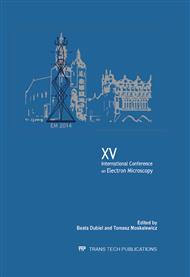p.11
p.19
p.25
p.33
p.41
p.49
p.57
p.65
p.73
Application of Electron Microscopy to Investigation of Corrosion of Mg-Al Alloys in Various Electrolyte Solutions
Abstract:
The Mg-Al alloys are the best-known and most commonly used magnesium alloys (especially AZ91 alloy). However, the AZ91 alloy offers insufficient corrosion resistance. Many investigations show that hydrogen is the main corrosive factor appearing during chemical reactions between magnesium and water in electrolyte solution. The main intermetallic phase in the AZ91alloy is the Mg17Al12 (β phase), which is a hydrogen trap. During corrosion, magnesium hydride forms inside the β phase, and this phase is brittle fractured when the inner stress caused by hydrogen pressure and expansion stress due to the formation of magnesium hydride is higher thanthe fracture strength. We examined the corrosion behaviour of AZ91 and AE44 magnesium alloysin 0.1M Na2SO4 solution and 3.5% NaCl solution. We analysed two Mg-Al alloys in order todetermine the various effects of hydrogen on these materials.
Info:
Periodical:
Pages:
41-47
Citation:
Online since:
June 2015
Authors:
Keywords:
Price:
Сopyright:
© 2015 Trans Tech Publications Ltd. All Rights Reserved
Share:
Citation:


